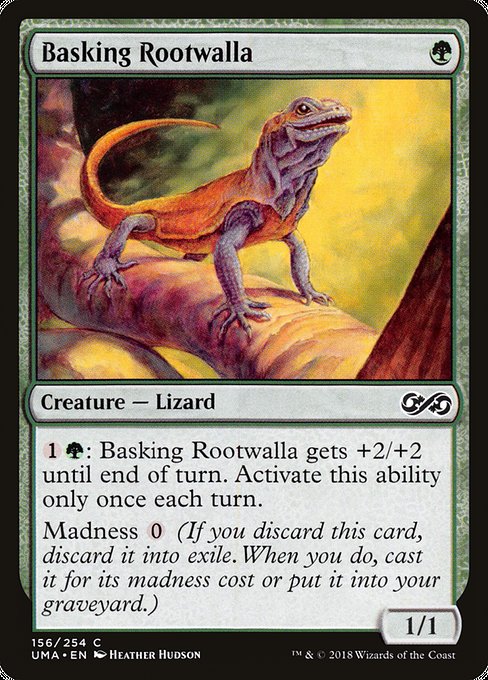
Image courtesy of Scryfall.com
Tiny Green Power, Big Market Lessons: How Basking Rootwalla Tells the Story of MTG Eras
Green creatures have long lived in the shadows of bigger-ticket spells, but a single 1-mana lizard with a cheeky twist can illuminate how MTG’s history treats value, design, and nostalgia 🧙♂️. The card in focus here—printed as a common reprint in Ultimate Masters—presents a compact, elegant bundle: a 1/1 body for a single green mana, a granted +2/+2 boost for a turn when you pay {1}{G}, and the quirky madness ability that makes it a bargain to discard and potentially recast. That interplay between immediate impact and long-term discard decisions is precisely the kind of design that keeps older cards relevant in newer eras 🔥.
Let’s ground this in the numbers we can actually track. Basking Rootwalla is a common rarity in UMA, a Masters set famous for revisiting familiar cards with a modern print kit. Its current market snapshot is modest: around 0.13 USD for the nonfoil, about 0.30 USD for the foil, and a few cents in the digital or arena-adjacent markets. In Euro terms, you’ll see a similar pattern: roughly 0.13 EUR nonfoil and around 0.45 EUR foil. Those figures aren’t the stuff of meteoric rise, but they tell a story about evergreen demand, reprint cycles, and the enduring appeal of classic green tricks in formats that still value access to nostalgia alongside playability 🪙💎.
Design elegance across eras: why a simple creature endures
The card’s skeleton is wonderfully lean: a green mana cost for a 1/1 body, obedient to the “play a creature, do something green” ethos. Its activated ability—{1}{G}: This creature gets +2/+2 until end of turn, usable once per turn—gives you a lightweight, tempo-friendly punch. In formats where the card is legal (Legacy, in particular, and the Commander family of formats), that burst can swing combat in a tight moment, turning a shy start into a surprisingly aggressive move. Then there’s Madness {0}: the gesture of discarding this card to cast it from the graveyard or exile, depending on how your deck wants to leverage it. That dual-life character arc—present in the same card—embodies a design ethos that gave early green a reputation for resilience and versatility. It’s a compact microcosm of how mechanics evolve across eras: quick, splashy effects paired with value in the graveyard, not just the battlefield 🎲⚔️.
In Ultimate Masters specifically, the reprint environment invites collectors and players to revisit that design space. UMA is known for bringing back familiar archetypes with a modern print quality, a move that both honors the past and fuels a fresh discussion about card value. The fact that Rootwalla remains a commons-level staple in this reprint environment helps explain its price floor: it’s accessible, it’s adorable to fans of older greens, and it showcases a classic engine in a modern wrapper. The trading-market narrative here is less about hitting a big spike and more about steady, nostalgia-fueled appreciation that tends to occur in waves around Masters-era reprints 🧩💚.
Investment, atmosphere, and the collector’s mindset
For investors and collectors, the value story isn’t just about a card’s current price. It’s about the emotional resonance of a card that ties together a player’s history with the game’s evolution. Basking Rootwalla is a prime example: a low-cost, high-nostalgia piece that traverses eras—from the early, simpler days of Mirage-era green to the modern, glossy reprint aesthetics of UMA. It’s also a reminder that “collectibility” isn’t only about rarity; it’s about whether a card remains relevant to decks people actually build—or at least want to discuss paper versions of. The card’s standing in formats like Legacy and Commander—where it’s legal—gives it a long runway for continued use or display, even as modern sets churn out more expensive, flashy rares. And for the art and lore crowd, Heather Hudson’s illustration adds another layer of charm that translates into other collectible pathways, such as prints, art cards, or just that warm, retro MTG glow on the shelf 🖼️🎨.
From an investor’s lens, theMadness ability provides a narrative hook: the possibility of “casting from the graveyard” at a bargain price if your strategy wants to leverage repeated discard outlets. It’s a reminder that MTG’s investment calculus isn’t only about creature power or mana curves—it’s about potential play patterns that emerge when you mix reliability with a touch of chaos. In UMA’s environment, those patterns aren’t always about outright power but about the cultural memory of what green could do, and how a humble 1/1 with a clever trick could become a cherished piece in a diverse collection 🧙♀️💡.
MAGSAFE Phone Case with Card Holder - Polycarbonate Matte or GlossMore from our network
- https://transparent-paper.shop/blog/post/effective-startup-communication-strategies-for-rapid-growth/
- https://blog.digital-vault.xyz/blog/post/blue-white-giant-illuminates-hidden-stellar-streams-in-sagittarius/
- https://crypto-acolytes.xyz/blog/post/distant-blue-hot-giant-reveals-color-as-age-indicator/
- https://blog.digital-vault.xyz/blog/post/smoliv-social-challenges-olive-powered-paldea-moments/
- https://blog.digital-vault.xyz/blog/post/how-to-create-organic-paper-rips-in-photoshop/